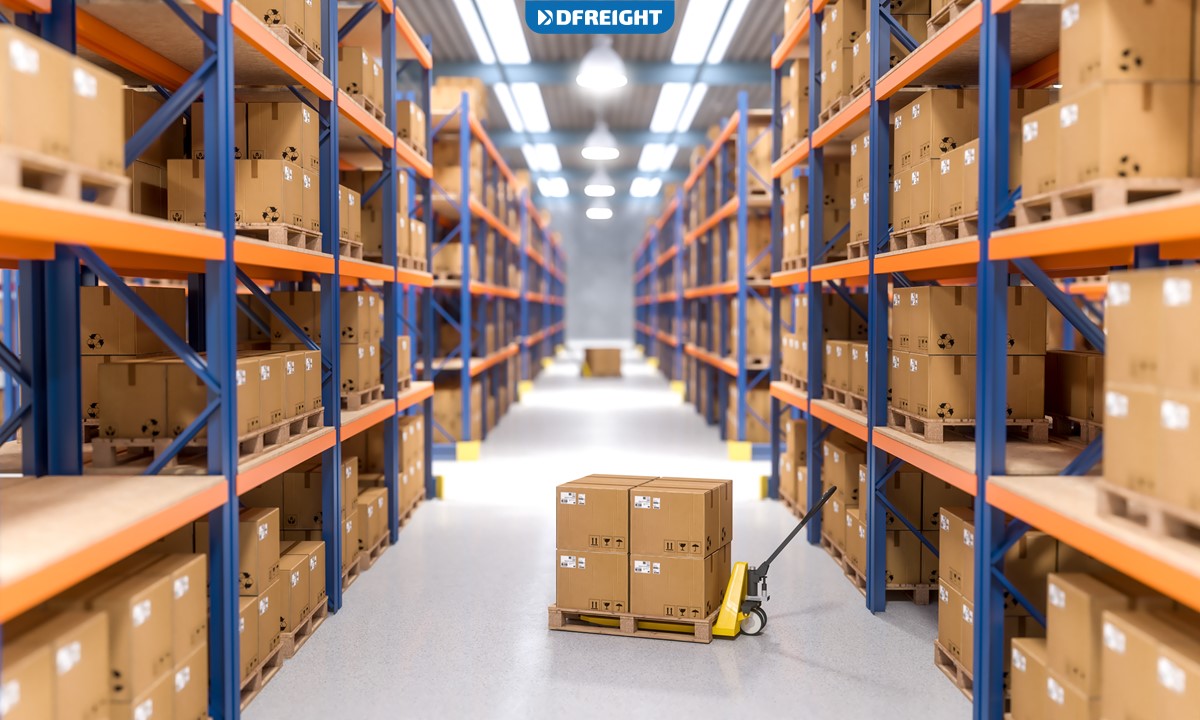In a world where billions of goods are shipped worldwide to fulfill the daily needs of billions of people, warehousing matters the most. The world supply chain’s efficiency, transparency, and reliability depend on modern warehousing. Without advanced warehousing solutions, there’s no doubt that the day-to-day operations of a business supply chain will be disrupted and lead to many inefficiencies. If your warehouse is not still equipped with the latest warehousing solutions, read this post to learn about four types of general warehousing solutions that can revolutionize your supply chain.
Table of Contents
What is a Warehouse?
A warehouse can be defined as “a building, or set of buildings, used for the storage of goods and materials.” Warehouses are used by manufacturers, importers, exporters, wholesalers, shipping companies, customs, etc. They are usually large plain buildings in industrial areas of cities and towns. They often have loading docks to load and unload cargo from trucks. Sometimes warehouses are designed for cargo loading and unloading directly from railways, airports, or seaports. They often have cranes, forklifts, and liftgates for moving goods, which are usually placed on the loading docks and rail tracks running through the warehouse.
A Brief History of Warehousing
The first warehouses were built in the early days of civilization to store grain. These early warehouses were often little more than a roof supported by columns to keep the grain dry and safe from rodents and birds. In ancient Rome, the grain warehouses were called horrea, often part of a complex that included a marketplace and offices for grain brokers.
In the Middle Ages, merchant guilds often built warehouses to store goods and materials owned by the guild members. By the 16th century, the use of warehouses had spread to Europe.
The industrial revolution brought new challenges to storing goods. With the increased production of goods, warehouses were needed to store finished products and raw materials. The first iron and steel warehouses were built in the late 18th century. These warehouses were fireproof and could store much more than the earlier wooden warehouses. In the United States, the first warehouses were built in the early 19th century.
The 20th century saw the development of many different types of warehouses, including refrigerated warehouses for storing perishable goods and bonded warehouses for storing goods subject to import duties. Today, there are warehouses of all sizes, from small warehouses that store a few thousand barrels of crude oil to massive warehouses that store millions of pounds of grain.
The role of warehouses has changed over time. In the past, warehouses were used primarily for storage. Today, warehouses are used for various purposes, including storage, distribution, assembly, and manufacturing.
Key Benefits of General Warehousing
General warehousing solutions are essential today because they can provide a business with a cost-effective way to store inventory and products. They can also help improve a business’s efficiency by providing a space to organize and manage inventory. Besides, warehousing solutions can help to protect inventory from damage or loss. Here are some key advantages of warehousing for your business:
- A warehouse can provide a safe and secure place to store your inventory and materials.
- You can save on costs by renting or leasing a warehouse rather than maintaining your own facility.
- A warehouse can give you the flexibility to store more inventory than you could at your own facility.
- A warehouse can provide easy access to transportation and shipping services.
- A warehouse can provide a variety of value-added services, such as packaging, assembly, and shipping.
An Introduction to General Warehousing Solutions

Warehousing solutions are systems that help organizations store and manage their inventory. There are many types of warehousing solutions, but they all share the goal of assisting organizations in storing and organizing their inventory efficiently.
The most common type of warehousing solutions is a Warehouse Management System (WMS), which helps organizations keep track of their inventory and manage their warehouse operations. Other types of warehousing solutions include Inventory Management Systems (IMS), Transportation Management Systems (TMS), and Enterprise Resource Planning (ERP) systems. Each type of warehousing solution has unique features and benefits, but they all help organizations store and manage their inventory efficiently.
Warehouse Management System (WMS)
A warehouse management system (WMS) is a software application that supports the day-to-day operations in a warehouse. This includes the receipt and storage of goods and the picking and shipping of orders. A WMS will also track inventory levels and locations and generate reports to support the efficient use of warehouse space and labor.
WMS systems are often integrated with other enterprise software applications, such as enterprise resource planning (ERP) systems and transportation management systems (TMS). This allows for a more seamless flow of information between different parts of the supply chain management and can lead to increased efficiencies and reduced costs.
The use of a WMS can help to improve customer service levels, as well as reduce inventory levels and storage costs. In addition, a WMS can help to optimize the use of labor and other resources within the warehouse.
Some of the more well-known options include:
- SAP WM
- Oracle Warehouse Management
- Manhattan Associates Warehouse Management
- JDA Warehouse Management
Inventory Management System (IMS)
An inventory management system (IMS) is a computer program that tracks inventory levels, orders, sales, and deliveries. It is often used with other software programs such as accounting or enterprise resource planning (ERP) systems.
IMS can also be used to track stock levels in a warehouse or distribution center. IMS systems are designed to help businesses keep track of their inventory and ensure they have the right products in stock to meet customer demand. IMS can also help enterprises to manage their supply chain and reduce inventory costs.
Many different types of IMS systems are available in the market today. Some of the most popular IMS systems include:
- Oracle Inventory Management System
- Microsoft Dynamics GP
- SAP Business One
- Infor M3
- IFS Applications
- Epicor
- Lawson
- Manhattan Associates
- JDA
- RedPrairie
Transportation Management System (TMS)
A transportation management system (TMS) is a software application designed to plan, execute, and optimize the transportation of goods. Shippers, carriers, and logistics service providers use TMS software to plan and track the movement of goods, usually via trucks, from one location to another. A TMS typically consists of three main components: a , a , and a .
Transportation Planning Module: TPM is used to generate shipping plans and schedules that take into account the specific needs of the shipper, carrier, and/or 3PL provider. This module also includes a load-building function that creates the most efficient way to load goods onto vehicles.
Transportation Execution Module: TEM is used to track shipments’ status in transit and manage the exchange of information between the shipper, carrier, and 3PL provider. This module also includes functions for tracking freight bills and payments.
Transportation Optimization Module: TOM is used to continuously monitor and adjust the shipping plans and schedules generated by the TPM to improve overall transportation efficiency. This module also includes functions for transportation data analytics and for generating reports.
There are many transportation management systems on the market, but some of the most well-known are:
- JDA Transportation Management
- SAP Transportation Management
- Oracle Transportation Management
- Manhattan Associates Transportation Management
- Blue Yonder Transportation Management
- Descartes Systems Group Transportation Management
Enterprise Resource Planning (ERP)
Enterprise Resource Planning (ERP) systems are business software suites that integrate and automate the critical business functions of an organization. They are usually deployed across the enterprise on a single platform and database, providing a real-time view of the organization’s data and operations.
ERP systems typically include modules for accounting, human resources, customer relationship management (CRM), inventory planning, and supply chain management (SCM). Some ERP vendors also offer project management, quality management, and compliance modules.
ERP systems are designed to streamline business processes and reduce operational costs. They can also help organizations to manage their resources better, improve decision-making, and increase transparency and visibility across the enterprise.
ERP implementations can be complex and time-consuming, so it is essential to partner with a reputable and experienced ERP vendor. An ERP system should be customized to fit the organization’s specific needs, and the vendor should provide comprehensive training and support to ensure a successful implementation.
Some of the most popular Enterprise Resource Planning (ERP) systems include:
- SAP
- Oracle
- Microsoft Dynamics
- Infor.
Final Words

Inventory management is a complex and time-consuming task for businesses, particularly those that sell products online and process a large volume of shipments daily. An effective warehousing solution can automate many tasks associated with inventory management, including stock replenishment, order picking, and shipping. This automation can free up time for businesses to focus on other areas of their operation.
In addition to improving efficiency, a warehousing software solution can also help businesses to save money. By tracking inventory levels and customer demand, companies can avoid overstocking their warehouse and incurring unnecessary storage costs. So, if your warehouse still lacks such solutions to streamline your supply chain, don’t hesitate to equip it with an appropriate warehousing solution today.
FAQs
What are the key benefits of warehousing?
A warehouse can provide your business with a safe and secure place to store your inventory and materials, easy access to transportation and shipping services, and various value-added services such as packaging, assembly, and shipping.
What are general warehousing software solutions?
General warehousing software solutions are designed to manage and streamline warehouse operations. They can help with inventory management, order fulfillment, shipping, and receiving. These solutions can be used to track and optimize warehouse space and to create efficient workflows.
What are the most common warehousing solutions?
Warehouse Management Systems (WMS), Inventory Management Systems (IMS), Transportation Management Systems (TMS), and Enterprise Resource Planning (ERP) systems are the most common warehousing software solutions.
Do cargo unloading services provide warehousing options?
Some cargo unloading services offer temporary warehousing options where unloaded cargo can be stored before further distribution or until it is picked up by the recipient.














